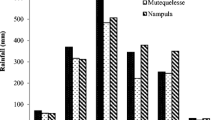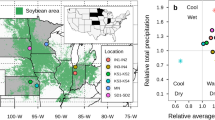Abstract
The development of cultivars of soybean (Glycine max L. Merr.) which are capable of near-maximum levels of N2 fixation in high-NO −3 soils remains a high priority in N2 fixation research. We report a field study to evaluate nodulation and N2 fixation by 32 genotypes of soybean, selected after two years of glasshouse screening for superior symbiotic activity in the presence of 2.5 mM NO −3 . The 32 “NO −3 -tolerant” genotypes and eight others (three commercial “check” cultivars and five “non-fixing” lines) were inoculated withBradyrhizobium japonicum CB 1809 and sown into a black earth soil (fine, montmorillonitic, thermic Udic Pellusterts) which contained high levels of soil NO −3 (260 kg N ha−1; 0 to 120 cm depth) and which was free of soybean rhizobia. Nitrogen fixation activity was assessed at 89 days after sowing using the relative abundance of ureides in xylem exudate [(ureide-N/ureide-N+NO −3 -N+α amino-N)×100] as an index of fixation. Plant growth and nodulation were assessed 11 days later. Genotypes 466, 468, 469 and 464, all of Korean origin, showed the highest levels of symbiotic activity. Many of the remaining 28 “tolerant” genotypes nodulated poorly in the field and displayed levels of N2 fixation (relative ureides) which were equivalent to two of the commercial “check” cultivars, Bragg and Elf. Correlation matrices of the measured parameters revealed highly significant correlations among the indices of nodulation and N2 fixation and poor correlation between those measurements and plant growth-seed yield. The levels of NO −3 tolerance, displayed by the four Korean lines, may prove useful in breeding programs which aim to enhance N2 fixation by soybean in high-NO −3 soils.
Similar content being viewed by others
References
Betts J H and Herridge D F 1987 Isolation of soybean capable of nodulation and nitrogen fixation under high levels of nitrate supply. Crop Sci. 27, 1156–1161.
Caldwell B E 1966 Inheritance of a strain-specific ineffective nodulation in soybean. Crop Sci 6, 427–428.
Devine T E 1984 Genetics and breeding of nitrogen fixation.In Biological Nitrogen Fixation. Ed. M Alexander. pp 127–154. Plenum Publ., New York, N.Y.
Fehr W R, Caviness C E, Burmood D T and Pennington J S 1971 Stage of development descriptions for soybeans,Glycine max (L.) Merrill. Crop Sci. 11, 929–931.
Gibson A H and Harper J E 1985 Nitrate effect on nodulation of soybean byBradyrhizobium japonicum. Crop Sci. 25, 497–501.
Hardarson G, Zapata F and Danso S K A 1984 Effect of plant genotype and nitrogen fertilizer on symbiotic nitrogen fixation by soybean cultivars. Plant and Soil 82, 397–405
Hardy R W F, Criswell J G and Havelka U D 1977 Investigations of possible limitations of nitrogen fixation by legumes: (1) methodology, (2) identification and (3) assessment of significance.In Recent Developments in Nitrogen Fixation. Eds W Newton, J R Postgate and C Rodriguez-Barrueco. pp 451–467. Academic Press, London, U.K.
Herridge D F 1984 Effects of nitrate and plant development on the abundance of nitrogenous solutes in root-bleeding and vacuum-extracted exudates of soybean. Crop Sci. 24, 173–179.
Herridge D F, Roughley R J and Brockwell J 1984 Effect of rhizobia and soil nitrate on the establishment and functioning of the soybean symbiosis in the field. Aust. J. Agric. Res. 35, 149–161.
Herridge D F, Roughley R J and Brockwell J 1987 Low survival ofRhizobium japonicum inoculant leads to reduced nodulation, nitrogen fixation and yield of soybean in the current crop but not in the subsequent crop. Aust. J. Agric. Res. 38, 75–82.
Holl F B and LaRue T A 1976 Genetics of legume plant hosts,In Proceedings on the 1 st International Symposium on Nitrogen Fixation. Eds W E Newton and C J Nyman. pp 391–399. Washington State Univ. Press, Wa.
Lawes D A, Mytton L R, El-Sherbeeny M H and Sorwli F K 1978 Symbiotic variation in field beans (Vicia faba). Ann. Appl. Biol. 88, 466–468.
McClure P R, Israel D W and Volk R J 1980 Evaluation of the relative ureide content of xylem sap as an indicator of N2 fixation in soybeans. Plant Physiol. 66, 720–725.
Mytton L R 1978 Some problems and potentialities in breeding for improved white clover-rhizobium (Trifolium repens-Rhizobium trifolii) symbiosis. Ann. Appl. Biol. 88, 445–487.
Phillips D A and Teuber L R 1985 Genetic improvement in symbiotic nitrogen fixation in legume.In Nitrogen Fixation Research Progress, Eds H J Evans, P J Bottomley and W E Newton. pp. 11–27. Martinus Nijhoff, Dordrecht, The Netherlands.
Smith R S, Ellis M A and Smith R E 1981 Effect ofRhizobium japonicum inoculant rates on soybean nodulation in a tropical soil. Agron. J. 73, 505–508.
Streeter J G 1985 Export of nitrogenous compounds from soybean roots.In World Soybean Research Conference III. Proceedings. Ed. R Shibles. pp 756–764. Westview Press. Boulder, Co.
Vest G 1970 Rj3—a gene conditioning ineffective nodulation in soybean. Crop Sci. 10, 34–35.
Weber C R 1966 Nodulating and nonnodulating soybean isolines: II. Response to applied nitrogen and modified soil conditions. Agron. J. 58, 46–49.
Williams L E and Phillips D A 1983 Increased soybean productivity with aRhizobium japonicum mutant. Crop Sci. 23, 246–250.
Author information
Authors and Affiliations
Rights and permissions
About this article
Cite this article
Herridge, D.F., Betts, J.H. Field evaluation of soybean genotypes selected for enhanced capacity to nodulate and fix nitrogen in the presence of nitrate. Plant Soil 110, 129–135 (1988). https://doi.org/10.1007/BF02143548
Received:
Revised:
Issue Date:
DOI: https://doi.org/10.1007/BF02143548




